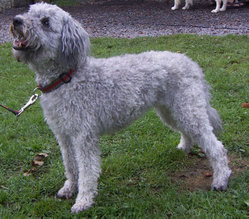
| Hungarian Pumi |
| FCI: | Group 1 Section 1 #56 | |
| AKC: | FSS | |
| ANKC: | Group 5 (Working Dogs) | |
| UKC: | Herding Dog breeds |
|
From Wikipedia the free encyclopedia, by MultiMedia |
| Pumi | ||||||||||
|---|---|---|---|---|---|---|---|---|---|---|
 |
||||||||||
| Alternative names | ||||||||||
|
||||||||||
| Country of origin | ||||||||||
| Hungary | ||||||||||
| Classification and breed standards | ||||||||||
|
||||||||||
| Notes | ||||||||||
| The AKC Foundation Stock Service is for beeds working towards full recognition |
The Pumi is a medium-small terrier-type breed of Dog. It is a sheep Dog from Hungary. The plural of Pumi is Pumik.
Most Pumi are gray, and almost any shade of gray is accepted in the show ring. Gray Pumi are born black but puppies usually start graying at the age of 6 to 8 weeks, and the shade gradually lightens. The final shade can be predicted by the color of the parents. Other accepted colors are black, white, and maszkos fakó, which is yellow-brown with a darker mask. This color is known as sable with mask in other breeds, such as the Tervueren. The graying often also affects the maszkos fakó Pumi puppies, and the adults are often just slightly shaded. Other colors are possible, but not accepted for show Dogs. Black and tan, brown, blue, and wolf-colored puppies are born occasionally.
The coat is curly, thick, and of medium length, approximately 7 cm long and consisting of a harsh topcoat and soft undercoat. The coat is maintained by combing every few weeks, and trimming every 2 to 4 months. The coat grows constantly (similar to that of the Poodle) and, if grooming is not maintaind, the coat may start matting.
The Pumi trademark is its ears, which are always alert and very lively. Ears are high-set and the tip bends down. Ears are covered with longer hair than the rest of the body.
The Pumi is a light-bodied, square Dog that looks slightly larger than it is because of the thick coat. The Pumi has a long, narrow head. The muzzle is 45% of the length of the head, which is of equal length to the neck. The stop is barely noticeable, and the skull is flat when seen from the side. The eyes are small, dark, and slightly oblique. Movements are lively and energetic, as is the Pumi itself.
Male Pumi stand 41 to 47 cm at the withers and weigh 10 to 15 kg; bitches are 38 to 44cm and weigh 8 to 13 kg.
The Pumi can be very protective of its own family, and often slightly reserved toward strangers, so socialization must begin early. The Pumi is a lively and active breed. It is intelligent but barks easily. Pumi are moderately easy to train, as it is easy to motivate using toys or food.
Pumik are a healthy breed with a life expectancy of 10 to 12 years, but Pumik have been known to live up to 17 years. Known medical problems are patella luxation and canine hip dysplasia.
The most extensive health records of the breed can be found from Finland and Sweden, and around 80% of the Pumik born there have healthy hips.
The Pumi was originally used as a herding Dog, but now, most of them are used for other purposes such as Dog agility, Dog dancing, and obedience, but also can be trained for detection, search and rescue, and other purposes. Pumi have been used also for hunting wild boar.
The Pumi has been used as a "general farm Dog", shepherding not only sheep but also cows and pigs, and also for catching small rodents. It originated in the 17th or 18th century, when shepherding terriers were brought to Hungary from Germany and France. These terrier-type Dogs mixed with the Puli-type Dogs that were in Hungary, and the result was a terrier-type herding Dog. As a working Dog, it was quite freely bred until the 1970s, and other Hungarian Dogs such as the Puli and Mudi were used for breeding. Until recently there has been a special B-registry for work bred Pumi. The parentage of these Dogs are unknown, but if they meet the breed standard, they can be given a "B-pedigree".
Pumi received FCI recognition in 1966. The breed was quite unknown outside Hungary until the 1970s. In 1973, the first Pumik were exported to Finland, and in 1985 to Sweden. Later, Pumik were exported also to Germany, Netherlands, Italy, and in the 1990s to the USA.
The Pumi is relatively unknown outside Hungary, but in Sweden and Finland around 100 Pumik are registered every year. In both countries, the Pumi is a very popular agility Dog, and pumik are seen almost every year in the Championship competition. In Scandinavia, the Pumi is used for obedience and Dog dancing competitions.
In 2004 Pumi was accepted to the American Kennel Club Foundation Stock Service program, and the Hungarian Pumi Club of America was founded.
Hungarian Pumi Club of America
Pumi, medium-small, terrier, breed of Dog, sheep Dog,
Hungary, Pumik